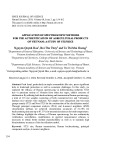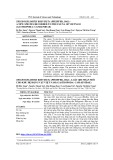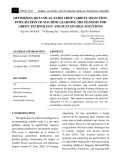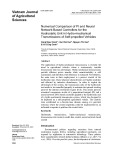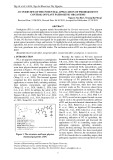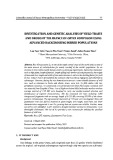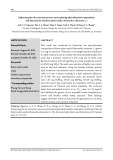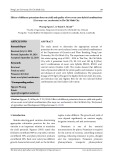
93
HUNG VUONG UNIVERSITY JOURNAL OF SCIENCE AND TECHNOLOGY Vol. 37, No. 4 (2024): 93 - 100
*Email: tranbinha4@gmail.com
TẠP CHÍ KHOA HỌC VÀ CÔNG NGHỆ
TRƯỜNG ĐẠI HỌC HÙNG VƯƠNG
Tập 37, Số 4 (2024): 93 - 100
HUNG VUONG UNIVERSITY
JOURNAL OF SCIENCE AND TECHNOLOGY
Vol. 37, No. 4 (2024): 93 - 100
Email: tapchikhoahoc@hvu.edu.vn Website: www.hvu.edu.vnjst.hvu.vn
CHARACTERISTICS OF MEDICINAL PLANTS BELONGING TO
MAGNOLIOPHYTA WITH POTENTIAL FOR INFERTILITY TREATMENT
IN KON CHU RANG NATURE RESERVE, GIA LAI PROVINCE
Tran Duc Binh1,2* , Bui Hong Quang2, Vu Anh Thuong2, Le Ngoc Han2, Vu Ha Phuong2,
Nguyen Thi Thanh3, Pham Duc Chinh3, Nguyen Thu Thuy2,4
1 Granduate University of Science and Technology,
Vietnam Academy of Science and Technology, Hanoi
2 Institute of Ecology and Biological Resources,
Vietnam Academy of Science and Technology, Hanoi
3 Institute of Regional Research and Development, Ministry of Science and Technology, Hanoi
4 International Biological Material Research Center,
Korea Research Institute of Bioscience and Biotechnology
Received: 02 December 2024; Revised: 12 December 2024; Accepted: 18 December 2024
DOI: https://doi.org/10.59775/1859-3968.240
Abstract
Infertility is an ancient condition that remains quite prevalent in modern society. As society becomes increasingly
modernized, factors such as lifestyle, diet, and work pressures have contributed to the growing incidence of
infertility. The use of medicinal plants to treat infertility is becoming a trend in Vietnam and other countries
around the world. The Kon Chu Rang Nature Reserve in Gia Lai Province holds immense potential with its
rich and diverse flora, including notable medicinal plants with therapeutic properties. We conducted seven
field survey trips to collect plant specimens, including two trips to interview the Bana ethnic group about their
medicinal plants. In this paper, we provide detailed morphological, biological, and ecological characteristics,
distribution, color images, and utilization value of five species, thus contributing to the knowledge base of
medicinal plant resources in the Kon Chu Rang Nature Reserve.
Keywords: Healing potential, medicinal plants, infertility, vascular plants, Kon Chu Rang.
1. Introduction
The use of plants in traditional medicine
dates back thousands of years, with knowledge
passed down through generations to the present
day. Research into the pharmacological effects
of medicinal plants has led to the discovery
of numerous new drugs and has greatly
contributed to the advancement of modern
medicine [1]. Medicinal plants are considered
an economically important resource within
natural biodiversity. The utilization of plants
for human healthcare is not only beneficial
for medical practices but also plays a
significant role in species conservation and
the diversification of medicinal plant genetic
resources [2]. Traditional medicine relies
heavily on the availability of plant resources
and a long-standing repository of knowledge,

94
HUNG VUONG UNIVERSITY JOURNAL OF SCIENCE AND TECHNOLOGY Tran Duc Binh et al.
with valuable information on medicinal
plants accumulated over centuries.
In Vietnam, extensive studies have
documented medicinal plant species with various
therapeutic uses. Notably, 19 species have been
identified for treating infertility [3], 26 species
for conditions such as nocturnal emissions,
erectile dysfunction, and spermatorrhea [4]; 62
species for spermatorrhea, and 42 species for
erectile dysfunction [5].
The Kon Chu Rang Nature Reserve
(KNR), part of the Kon Ha Nung Biosphere
Reserve, holds exceptional importance in
biodiversity conservation and ecological
protection. It harbors significant biodiversity
potential, particularly in its flora and the
diversity of medicinal plant species [6-8].
This study aims to provide additional
data on medicinal plant resources with
potential infertility treatment applications,
contributing to the foundation for the
conservation and sustainable development of
medicinal plant resources in the KNR.
2. Methods
Methods: The study compiled data on
plant species in the Nature Reserve (KNR)
through field surveys and specimen collection
(conducted in July 2017, September 2017,
October 2020, April 2022, December
2022, September 2023, and January 2024).
Interviews were also conducted with the Bana
ethnic group about medicinal plants in Sơn
Lang commune (Điện Biên village), Dark
Grong commune (Con Von I village, Con
Von II village) in August 2018 and January
2024. Species identification was performed
using the morphological comparison method
[9, 10]. Medicinal plants were recorded for
50 disease categories [5, 11].
Additionally, the morphological
comparison method was employed for
species identification. Collected specimens
were analyzed and compared with standard
type images of the identified species, and
scientific names were updated [12, 13].
Specimen collection was conducted
following the method described by Nguyen
Nghia Thin [14]. Local knowledge and
traditional practices were investigated during
field trips (plant parts used, and traditional
applications, as described) [15].
3. Results and Discussion
3.1. Statistics on the number of species by
medicinal uses
A total of seven field surveys were
conducted, including two trips to interview
the Bana ethnic group about medicinal plants.
These interviews recorded 43 remedies
from 17 Bana individuals about 199 species
belonging to Magnoliophyta with medicinal
value have been identified (Table 1).
Table 1. The 10 families and 10 genera with the highest number of species used in KNR
No. Family Number of species No. Genus Number of species
1FABACEAE 24 1 Syzygium 9
2 LAURACEAE 22 2 Elaeocarpus 6
3EUPHORBIACEAE 14 3 Ficus 6
4 FAGACEAE 14 4 Lithocarpus 5
5 MELIACEAE 12 5 Litsea 5
6 MORACEAE 11 6 Castanopsis 5
7 MALVACEAE 11 7 Magnolia 5
8 SAPINDACEAE 11 8 Quercus 4
9 MYRTACEAE 9 9 Archidendron 4
10 PHYLLANTHACEAE 9 10 Ilex 4
Total 137 Total 53

95
HUNG VUONG UNIVERSITY JOURNAL OF SCIENCE AND TECHNOLOGY Vol. 37, No. 4 (2024): 93 - 100
These species were classified by their
uses in treating various diseases, as detailed
in Table 2.
Table 2. List and number of species by
disease types in KNR
No. Disease types Number of
species
1 Tranquillizer 5
2 Vaginitis 12
3 Paralytic 3
4 Obese 0
5 Flu 7
6 Eyesore 3
7 Toothache 5
8 Detoxify 6
9 Syphilis 2
10 Asthma 7
11 HIV AIDS 1
12 Gonorrhoea 5
13 Dysentery 37
14 Galactopoietic 2
15 Diuretic 10
16 Mumps 1
17 Snake bite 28
18 Urolithiasis 5
19 Malaria 16
20 Rheumatism 56
21 Diabetes 5
22 Heart and blood pressure
diseases 11
23 Haemorrhoids 7
24 Cancer 1
25 Gastritis 6
26 Hepatitis 24
27 Keratitis 0
28 Sore throat 11
29 Encephalitis 2
30 Nephritis 15
31 Sinusitis 3
32 Sterile 5
33 Cirrhosis 4
34 Brain hemorrhage 0
35 Pimple 0
36 Hemostatic 4
37 Fracture 3
38 Burned 2
39 Pneumonia 0
40 Bronchitis 0
41 Hurt fall 2
42 Irregular menstruation 3
43 Kidney stone 4
44 Measles 3
45 Headache 1
46 Inflammatory bowel 2
47 Oedema 3
48 Otitis 4
49 Pertussis 2
50 Scrofulous 0
3.2. Characteristics of medicinal plants
used for infertility treatment
3.2.1. Viburnum lutescens Blume (Fig. 1.1)
Family: Adoxaceae
Vietnamese name: Vót vàng nhạt
Description: Shrub, to 3-6 m tall. Leaves
opposite. Leaf blade elliptical, 8-10 cm,
hairy, with 5 pairs of secondary veins,
margins serrate. Secondary veins and petioles
covered with stellate hairs. Petiole 1-1.3 cm.
Inflorescences terminal, usually cymose.
Flowers solitary. Corolla cream-colored,
wheel-shaped when open. Calyx pale green,
0.8-1.5 mm. Stamens exserted. Fruit single-
seeded, black, 9–10 mm.
Biology and Ecology: Scattered in
secondary forests and forest edges. Flowering
occurs from July to September, and fruiting
from November to December.
Distribution: Son La, Bac Kan, Thai
Nguyen, Thanh Hoa, Gia Lai (KNR), Kon
Tum (Kon Plong, Mang Canh), Lam Dong
(Bao Loc). India, China, Laos, Indonesia.
Specimen examined: Gia Lai, K’Bang,
KNR, KCR 141 (HN).
Usage: Branches and leaves are used to
treat infertility caused by ovarian obstruction.
They are also boiled to prepare a bath for
postpartum women to aid recovery and
prevent puerperal fever [9].
3.2.2. Heptapleurum heptaphyllum (L.)
Y.F. Deng (Fig. 1.2).
Family: Araliaceae
Vietnamese name: Đáng chân chim
Synonym: Schefflera heptaphylla (L.)
Frodin
Description: Tree, up to 15 m tall. Petiole
(5)10–30 cm; leaflet petiole 1.5–5 cm.
Leaves compound with 6–9(–11) leaflets,

96
HUNG VUONG UNIVERSITY JOURNAL OF SCIENCE AND TECHNOLOGY Tran Duc Binh et al.
elliptical to ovate-elliptical or ovate, ca.
7–18 × 3–5 cm, papery to leathery. Young
leaves densely covered with stellate hairs,
with main veins glabrous. Secondary veins
7–10 pairs; base wedge-shaped to obtuse
or rounded; margin entire, often serrated or
lobed when young; apex acute to acuminate.
Inflorescences terminal, panicle- or umbel-
like, covered with stellate hairs; rachis up to
35 cm, peduncle 4–5 mm. Calyx hairy, entire
or with 5–6 teeth. Ovary with 5–9(–10)
carpels; style ca. 1.5 mm. Fruit smooth, ca. 5
mm, ribbed when dry.
Biology and Ecology: Scattered in moist
evergreen forests, at elevations of 100–1,500 m.
Flowering occurs from November to March
(following year), fruiting from April to June.
Distribution: Son La, Cao Bang, Lang
Son, Quang Ninh, Bac Kan, Thai Nguyen,
Bac Giang, Vinh Phuc, Hoa Binh, Hanoi,
Ninh Binh, Gia Lai (K’Bang, Tram Lap,
Dong Commune), Lam Dong, Ba Ria-Vung
Tau. China, Japan, Laos, Thailand, Indonesia.
Specimen examined: Gia Lai, K’Bang,
KNR, KCR 336, VK4812 (HN).
Usage: The bark and root bark are used to
treat rhinitis, influenza with fever, sore throat,
rheumatoid arthritis, traumatic bruises,
paralysis, muscle spasms, lymphadenitis,
orchitis, erectile dysfunction, vaginal itching
in women, edema, and as antidotes for
Gelsemium elegan poisoning and cassava
intoxication [5, 9].
3.2.3. Rubus alceifolius Poir. (Fig. 1.3,
1.4)
Family: Rosaceae
Vietnamese name: Mâm xôi
Description: Climbing, up to 5 m. Leaf
blade nearly circular to broadly ovate, 6-16
× 5–14 cm, typically 5-veined, leathery.
Adaxial surface pale yellow-gray to reddish
hairy, with hairs on secondary veins;
Adaxial surface sparsely hairy, prominent
on secondary veins. Base obtuse, margin 5-7
lobed. Petiole 3-4.5 cm, pale yellow-gray to
reddish tomentose. Inflorescence terminal,
nearly cymose, 6–11 cm, occasionally
with few flowers in axils, rarely solitary;
branches and peduncle tomentose with spots.
Bracts 1–1.4 cm, lobes linear or lanceolate.
Peduncle 5–10(15) cm. Flowers 1–1.6 cm
in diameter. Calyx outer surface hairy; tube
cup-shaped, ovate to triangular-ovate, 6–9
× 5–8 mm. Corolla white, nearly round to
broadly obovate, 5–9 × 4–9 mm, clawed at
the base. Numerous stamens, shorter than
the corolla; filaments 5 mm, anthers sparsely
short-haired. Ovary and style smooth. Fruit
red, nearly spherical, ca. 1.8 cm; seeds
wrinkled.
Biology and Ecology: Scattered in open
forests, forest edges, and waste lands, at
elevations up to 1800 m. Flowers from
February to March, fruits from March to July.
Distribution: Lai Chau, Lao Cai, Son
La, Ha Giang, Cao Bang, Lang Son, Quang
Ninh, Bac Kan, Thai Nguyen, Bac Giang,
Bac Ninh, Phu Tho, Vinh Phuc, Hoa Binh,
Hanoi, Ha Nam, Ninh Binh, Thanh Hoa,
Nghe An, Quang Tri, Thua Thien Hue, Da
Nang, Quang Nam, Gia Lai (KNR), Kon
Tum, Dak Lak, Lam Dong. Cambodia,
China, Indonesia, Japan, Laos, Malaysia,
Myanmar, Philippines, Thailand.
Specimen examined: Gia Lai, K’Bang,
KNR, KCR 133 (HN).
Usage: Fruits are palatable. Branches and
leaves are boiled as a tea substitute, aiding
digestion and acting as a diuretic. Fruits
treat kidney deficiency, spermatorrhea,
erectile dysfunction, enuresis, and dysuria.
Branches and leaves are used to treat
hepatitis, mastitis, oral ulcers, and regulate

97
HUNG VUONG UNIVERSITY JOURNAL OF SCIENCE AND TECHNOLOGY Vol. 37, No. 4 (2024): 93 - 100
menstruation or induce abortion. Fruits also
address kidney pain, seminal stasis, enuresis,
nocturnal emissions, and spermatorrhea.
Dosage: Decoction of 20-30 g or combined
with Morinda officinalis (Ba kich) and Rosa
laevigata (Kim anh), 10-15 g each [9].
3.2.4. Gynochthodes officinalis (F.C.
How) Razafim. & B. Bremer (Fig. 1.5, 1.6)
Family: Rubiaceae
Vietnamese name: Ba kích
Description: Perennial climbing shrub
with twining stems. Young branches angular,
purple, and hairy, glabrous when mature.
Leaves opposite, lanceolate or elliptic-
ovate; leaf blade rigid, hairy along margins
and veins, less hairy and whitish with age,
6-15 × 2.5-6 cm; petiole short. Stipules thin,
closely appressed to the stem. Flowers small,
clustered in umbels at branch tips, white
when newly opened, turning slightly yellow;
corolla fused below into a short tube. Fruits
spherical, borne on individual stalks, red
when ripe.
Biology and Ecology: Scattered in
secondary forests, forest edges, thickets,
and waste lands. Flowers from May to June;
fruits from July to October.
Distribution: Lao Cai, Ha Giang, Lang
Son, Quang Ninh, Bac Giang, Bac Ninh,
Bac Kan, Thai Nguyen, Phu Tho, Vinh Phuc,
Hanoi, Ninh Binh, Gia Lai (KNR). China.
Specimen examined: Gia Lai, K’Bang,
KNR, KCR 105 (HN).
Usage: Morinda officinalis is used to treat
erectile dysfunction, rheumatism, weak and
soft tendons, and lumbar pain. It is also a
popular folk remedy for enhancing mental
and physical vitality, treating premature
ejaculation, nocturnal emissions, impotence,
delayed menstruation, amenorrhea,
rheumatism, and hypertension. The usual
dosage is 8–16 g in the form of decoctions,
liquid extracts, pills made from extracts,
or medicinal wine. Traditionally, the roots
of wild plants are cooked with meat for
nourishment or soaked in alcohol to improve
health [5, 9].
3.2.5. Paranephelium spirei Lecomte
(Fig. 1.7, 1.8)
Family: Sapindaceae
Vietnamese name: Song chôm Spire
Description: Tree, 10-25 m tall. Leaves
pinnately compound with a common petiole
10–15 cm, bearing 5 leaflets with 9-10
pairs of secondary veins. Flowers arranged
in clusters at the branch tips or leaf axils;
calyx 5; petals 5, ca. 1 mm, scaly. Stamens
8-9, ovary 3-locular, spiny. Fruit spherical,
3 cm in diameter, dehiscent into thick, spiny
segments. Seeds solitary, round, reddish-
brown.
Biology and Ecology: Grows in lowland
forests at elevations around 300 m. Flowers
in March; fruits in August.
Distribution: Bac Giang, Da Nang, Gia
Lai (KNR). China, Laos, and Malaysia.
Specimen examined: Gia Lai, K’Bang,
KNR, VK4447 (HN).
Usage: The seeds yield oil. Roots are
used in decoctions to treat impotence and
in baths for cirrhosis and ascites (folk
medicine) [5, 9].
Through the process of interviewing
and specimen collection, the number of
encounters with the five species remains
relatively low. Therefore, for conservation,
it is recommended to implement
protective measures, such as establishing
protected areas within KNR to prevent
habitat destruction and overexploitation.
In-situ conservation efforts, such as habitat

